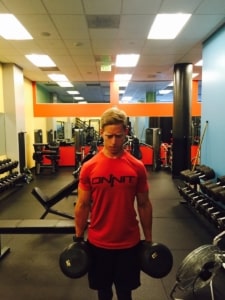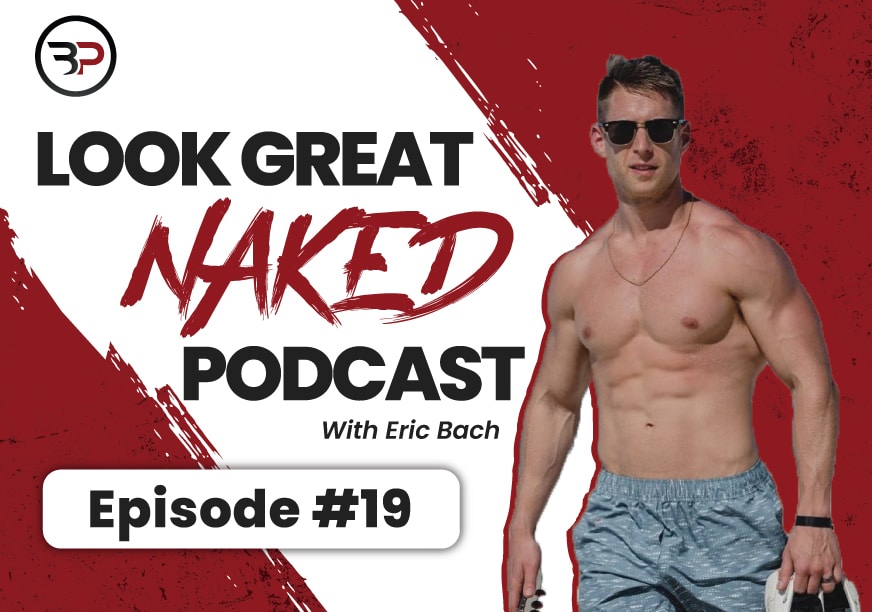Five Surprising Ways to Get Strong Fast
March 13, 2017
 Every successful lifter agrees on one thing: the gym is for getting bigger and stronger.
Every successful lifter agrees on one thing: the gym is for getting bigger and stronger.
And no wonder getting as strong as possible makes every goal inside and outside the gym easier. Thus, the question becomes: “How do I continue to get stronger?”
Maximizing strength is all about creating tension. That’s why “stay tight” is the most common cue in heavy lifting.
Below, I’ll:
- Outline the process of building strength
- Explain why it’s so important…even if you just want to look better naked.
- Hook you up with five easy-to-implement strength-building tricks you can start using right away
Why We Need Strength: The SAID Principle
Strength provides a foundation for every other physical skill, whether it’s getting jacked or looking better naked.
Without strength, your performance and physique goals remain just those: out of reach goals. First, comes an understanding of strength and adaptation. Then comes specialization. Maximizing your training comes down to the most basic principle of all: the SAID Principle.
The SAID Principle
How we respond stress was best described by Dr. Hans Selye as the General Adaption Syndrome (GAS.)
GAS states that the body goes through a specific set of responses (short term) and adaptations (longer term) after being exposed to an external stressor. Heavy barbell work is one example.

The theory holds that the body goes through three stages. Two contribute to survival. A third involves a failure to adapt to the stressor resulting in DEATH, or a disheartening lack of #gainz.
It follows that our goal should be to stress the body beyond its seeming capability. Recovery follows. And then we keep pushing the envelope.
Hey, that sounds a lot like progressive overload, right?
Stages of SAID
According to Practical Programming for Strength Training by Mark Rippetoe and Lon Kilgore, these are the stages of GAS and their relation to training (3):
Stage 1: Alarm or Shock
Alarm or shock is the immediate response to stress or lifting. An example is a soul-crushing soreness that keeps your ass glued to the toilet the day after squats. You feel flat, sore, but you recover for your next workout. The more advanced you get, the more stress needed to create a shock response.
Stage 2: Adaptation or Resistance
Adaptation occurs as the body responds to training and attempts to equip itself with the tools to survive the next onslaught of stress. An example is developing bigger quads and glutes to handle more and heavier squats. This occurs through hormonal adaptations, nervous system changes, and tissue building.
Stage 3: Exhaustion
Commonly called overtraining, this is what happens when you do too many squats on too little sleep while eating too much shit food. Perform decreases from too much training and poor recovery. A better approach is training to force adaptation. Then recover fully to build strength and muscle.
Building Muscle and Heavy Lifting
Brad Schoenfeld is a must read for all iron enthusiasts. His research suggests muscle building comes down to mechanical tension, metabolic stress, and muscular fatigue (4).
So what does this mean for my fellow muscle heads?
Without a base of strength, your muscle building efforts are futile.
10×10 training isn’t effective when you’re benching 15 lb. dumbbells. You need a foundation of strength to maximize volume and before tackling more advanced muscle building methods.
Get strong first. Your body must adapt to greater levels of strain or it won’t grow. This is especially true for beginners.
Now, I’m not saying chasing the pump and leaving the gym with big, veiny, triumphant biceps is bad. But if want to get jacked, it’s more effective to get your pump after recruiting the maximum number of muscle fibers and moving heavier weights.
Fat Loss, Diet, And Lifting Heavy
We all know poor diet is the biggest reason people fail at fat loss. But many overlook another important factor: excess muscle loss resulting from neglecting heavy strength work.
While some muscle loss occurs during aggressive diet plans, training for strength offset most of the damage through two major mechanisms:
First, heavy lifting increases nervous system recruitment. Lifting heavy stimulates muscle fibers to fire, helping you maintain strength and size even when your body is trying to break down your beloved biceps into enough energy to make it through your work day.
Second, lifting heavy stimulates the release of everyone’s favorite hormone: Testosterone. Since staying in a caloric deficit over time can decrease anabolic hormone levels, lifting heavy is essential to maintain an ideal hormonal environment for gym performance. Research and decades of anecdotal evidence show heavy compound lifts are essential to elevating testosterone. (1,2)
Taken from science to practice, lift heavy with 75-95% 1RM for 3-4 sets of 2-6 reps on compound lifts like squats even once per week can aid in muscle retention. Which leads us to five awesome tricks to help you lift more weight, stay jacked, and build more muscle.
Five Instant Strength Upgrades
Squeeze the Bar
The body functions as an integrated unit, rather than one muscle firing completely on its own.
Here’s a small test to reinforce that notion. Stand up and stay relaxed. No tension, right? Now, squeeze your fists as hard as possible. Do you feel the tension spread from your white-knuckles into your forearms, biceps, triceps, chest, and shoulders?
That’s irradiation, the process of activating more muscle fibers via the activation of surrounding muscle fibers.
What To Do: When used in lifting, grabbing the bar and squeezing as hard as possible during lifts fires the nervous system to recruit as many muscle fibers as possible.

Whenever you’re lifting, create tension through irradiation by squeezing the bar like you’re holding onto ten million bucks. This recruits nearby muscle fibers to provide extra stability, such as firing up your rotator cuff during pressing movements, for stronger lifts and safer training.
Push Through the Floor
We’ve all seen what happens when a lifter is bench-pressing near failure. They twitch and squirm. Then comes the spastic leg kick. Voila: The bar is stuck on their chest. Yikes.
In nearly every lift, a mental focus on driving your heels through the floor improves strength. Magical PRs await!
What To Do: On a bench press, driving your feet stabilizes the torso and provides a greater base from which to push from.
On deadlifts and squats focus on driving your feet through the floor for improved stability and strength.
Squeeze Dat Ass
Beyond being the primary driver of hip extension and the biggest muscle in your body, strong glutes aid in stabilizing your lumbar spine and knee. OH. And nice glutes make you hotter. #Science, right J-Lo?
Unfortunately, we spend hours with our asses planted, leading to decreased activation and what Dr. Stu McGill terms “gluteal amnesia.” Beyond leaving us with what I call pancake ass, poor glute activation may lead to back pain, increased the chance of knee injury, and pathetic lower body strength.
Why?
Strong glutes lead to strong lifts. Strengthening the muscles primarily responsible for hip extension, your glutes makes you stronger in lifts that need hip extension. Not surprisingly, the exercises that drive performance are the squat, deadlift, clean, sprints, and jumps, all of which require hip extension. Fire the glutes. You’ll be on the way to better booties, pain-free performance, and stronger lifts.
What To Do: During your upper body presses, squeeze your glutes to lock in trunk stability and prevent “swayback” pressing. On deadlifts, squats, and lower body exercises finish the top of each lift with a 1-2 second glute squeeze. Squeeze as hard as you can and you’ll be well on your way to a better booty, pain-free performance, and stronger lifts.
Breathe Through Your Nose
I recently heard the phrase: “You should breathe through your mouth as often as you eat through your nose.”
Troubling image, indeed. And despite being a highly evolved species, our group of mouth-breathing neanderthals sucks at one basic human function: breathing.
To test your breathing lay flat on the ground, facing the ceiling. Place one finger on the inside groove of your iliac crest, that pointy hip bone on the front side of your torso.
Now, breathe in through your nose, pulling air into your stomach, lower abdomen, and groin. Breathe in for 3-5 seconds, and then exhale as much air as possible, making sure the guy in the next cubicle next door can hear you.

If you notice your chest is rising instead of your stomach, you’ll need to improve your breathing. Beyond the health benefits, daily meditation practice can provide a daily practice to improve breathing. In time you’ll calm down your keyed-up nervous system while improving your diaphragmatic breathing patterns.
What To Do: During your big lifts, focus on filling your belly button with air. Hold and maintain tension as your diaphragm maximizes intra-abdominal pressure. This creates maximum tension and protects your spine for pain-free strength gains. But don’t forcefully exhale or you’ll lose all tension. Treat exhalation as a by-product, rather than a necessity on your heavy lifts.
Spiral Your Way to Strength
The spiral (or corkscrew) technique works for over upper and lower body exercises.
On upper body exercises, it stabilizes the glenohumeral joint (this is mental masturbation and the complicated way of saying shoulder joint) for additional stability. This external rotation torque helps fire the joints, tissues, and ligaments that support your shoulder. As a result, you’ll have a bigger base of strength pressing to optimally train your chest, tri’s, and shoulders for greater levels of strength.
What To Do: During your warm-ups, perform 2-3 sets of 10 push-ups. Push your hands through the ground and simultaneously try to externally rotate/corkscrew your hands into the floor.
On lower body lifts, drive and corkscrew your feet into the ground, as if you were ripping’ the floor apart. This sets your femur into the hip socket to improve gluteus maximus recruitment and optimizes hip and back stability. This helps you generate massive improvements in strength and stability for superhuman strength gains.
If you want more strength and muscle, you need tension. By applying these five methods you’ll supercharge strength, stability, and neurological output for new PRs, rapid progress and the muscle to rapidly change your physique.
JOIN THE ELITE 10%
90% of lifters make excuses, get overwhelmed, and never get jacked. The other 10%? They reside in the Bach Performance Community. Sign up today for the latest scientifically proven, experienced backed tips to get you jacked.
It starts with a simple gift: Your Chiseled Muscle Cheatsheet. I’ll reveal the step-by-step process to building high-performance muscle. You’ll get strong, lean and athletic.
All you have to do is click here to grab your FREE Gift. Enjoy!
Resources:
1. Giustina A, Veldhuis JD. Pathophysiology of the autoregulation of growth hormone secretion in experimental animals and the human. Endocr Rev 1998;19:717-797.
2. Kraemer, WJ, Fry AC, Warren BJ, et. al. Acute hormonal responses in elite junior weightlifters. Int J Sports Med 1992;13:103-109.
3. Rippetoe, Mark, and Lon Kilgore. Practical Programming for Strength Training. Wichita Falls, TX: The Aasgaard Company; 2nd editon, 2009.
4. Schoenfeld, Brad. “The Mechanisms of Hypertrophy and Their Application to Resistance Training.” Journal of Strength and Conditioning Research. 24.10 (2010): 2857. Web. 21 Nov. 2013.









Nice, simple and straightforward ways to improve your lifts. Good work Eric.
Thank you, Shane!